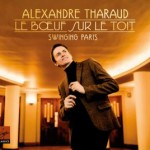In the final scenes of Mahlermania, a ‘dramatic fantasy with music by Gustav Mahler’ conceived by the troupe Nico and the Navigators in cooperation with the Deutsche Oper to inaugurate the West Berlin opera house’s new alternative stage Tischlerei on November 27, manuscript paper and fur coats scatter across the stage in front of a dismembered composing hut. An actress representing Alma Mahler, donning a fur hat and trench coat, douses herself with champagne. In the midst of a chamber performance of Abschied from Das Lied von der Erde, a figure representing the alter-ego of the composer lets out a blood-curdling howl. “Es gab Mozart, Schubert,” blurts out Alma. “Damit muss man sich abfinden” (‚There was Mozart, Schubert. One was to resign oneself to it.’). The Viennese seductress is reduced to a superficial socialite when a dancer, also Alma, waves at the audience Miss America-style.
Few historical relationships lend themselves better to a theatrical realization than the tumultuous marriage of the Mahlers, ridden by the composer’s illness, his impotence alongside the ambitious Alma, and her affair with the architect Walter Gropius, not to mention the death of their first child. Mahlermania assembles a program of chamber arrangements by Anne Champert, Rainer Riehn, and Arnold Schönberg ranging from the celestial third movement of the Fourth Symphony to songs from the Knaben Wunderhorn and Rückert Lieder cycles, which are narrated with an experimental mix of dance and theater. At the center of the action is a speed-talking Alma (Annedore Kleist) whose insatiable materialism cannot be harnessed.
Gustav’s infamous sense of being “three times homeless” as a Bohemian among Austrians, an Austrian among Germans, and a Jew throughout the world is represented with suitcases, pacing, close-ups of actors in awe-struck expressions, and the lowly shack—alongside a nearly obsessive amount of furs. At one point, Kleist reveals the history of each directly to the audience, in English—“I posed in this one for Kokoschka, totally nude…1910, New York.” More effective than such indulgent sarcasm are gestures that allow the music to breathe, such as a video projection of rolling waves onto the gauze sphere surrounding the members of the Deutsche Oper orchestra during the third movement of the First Symphony.
Mezzo soprano Katarina Bradic and baritone Simon Pauly bring sensitive musicianship to Mahler’s songs and blend well dramatically, but their performances are often intercepted by failed attempts to add psychological depth, such as the dancer Anna-Luise Recke’s ravenous munching of an apple during Bradic’s earthy tones in the devastating “Ich bin der Welt abhanden gekommen” (‘I am lost to the world’) of the Rückert Lieder. A few dance episodes gain more traction, such as when the athletic Frank Willens psychoanalyzes the lithe, Sasha Waltz-inspired moves of Recke as ego-driven before scaling the bare walls of the hut, but the Freudian twist become hackneyed as Willens takes on a purely theatrical role, diagnosing Alma as he puffs on a cigarette.
Nico and the Navigators cannot be criticized for allowing tastelessness to overrun their concept, sparing the audience the nudity and fake blood that have become signatures in German theater, but the high point lies in the musical gems brought together for the occasion. Moritz Gnann and his 16-head ensemble capably evoked the composer’s brushes with death and sighs at the world’s beauty with gleaming tone in the woodwinds, even if the string section led by Detlev Grevesmühl could have benefitted from more flexible lyricism. The new Tischlerei, a generous concrete space with raked seating designed by German architect Stefan Braunfels, provided intimate acoustics.
The new stage for experimental Musiktheater, having secured support from the Berlin Senate, the pharmaceutical company Aventis, and other private sponsors, has the potential to incubate exciting collaborations in a city where the alternative scene is just starting to win the attention and funding for which it has long been fighting. In a post-performance celebration over pro secco and pretzels, young creatives mingled with the bourgeois core audience of the Deutsche Oper as well as the new Intendant Dietmar Schwarz and the city’s Culture Secretary André Schmitz. The German capital is fortunate to be booming while recession beleaguers many parts of Europe. Yet if Mahlermania stands an example of what is to come at the Tischlerei, it is the dramaturgy that will provide the biggest challenge.



Widmann’s Opera Babylon
Friday, November 23rd, 2012By ANDREW POWELL
Published: November 23, 2012
MUNICH — Scorpion-Man prowls the rubble of an unnamed flattened city at the start of Babylon, Jörg Widmann’s new opera, wailing as he moves. We should care.
Seven scenes, a Hanging Garden interlude, and three costly theater hours later, he is back, doing his thing over the same debris, also multiplying himself, and alas we have not cared or even learned what he represents. Perhaps he is us sad cityites, predatory and detached from our souls.
Widmann’s librettist for this Bavarian State Opera commission (heard and seen Oct. 31) is the post-humanist philosopher Peter Sloterdijk, whose worries, intra-urban and intra-galactic, drive Babylon in one big circle against the backdrop of the 6th-century-BC Jewish exile.
Sloterdijk’s narrative feebly pivots on a love-interest, in the persons of exile Tammu and local priestess Inanna. The character Soul is catalyst in a progression of these two that ends, before the circle has closed, in a concordance of Heaven and Earth (cue sweet music).
Along the way, Tammu gets drugged, laid, sacrificed, resurrected, and flown away with his gal in a spaceship. After administering the drug and enjoying her man, Inanna’s one job is to descend post-sacrifice into the Underworld and retrieve him, being sure not to lose sight of him as they make their way out together.
If this suggests a too-rich stew of Isolde or Norma and Euridice with Tamino, it is. But we are in Babylon, and your bowl arrives as the Euphrates overflows, the New Year rings in at the Tower of Babel, and Ezekiel dictates the Word of God, not to list the antics of seven Sloterdijk planets and fourteen Poulenc-ish sex organs.
Born here in 1973 and locally esteemed, Widmann as composer is much identified with Wolfgang Rihm, one among several teachers and influences. He is, besides, a bold and expressive clarinetist: a 2012 Salzburg Festival performance of Bartók’s Contrasts with Alexander Janiczek and András Schiff all but vaulted off the Mozarteum’s platform, and a 2011 Munich partnership with the Arcanto Quartet found rare vigor as well as cozy plushness in Brahms’s Clarinet Quintet.
The Nabucco-era subject had taken the composer’s fancy long ago. Ideas sprouted. A raucous Bavarian-Babylonian March emerged as orchestral fruit last year, bridging the millennia if not exactly the cultures. At some point came the link with Sloterdijk and the decision to plough forth with an opera, Widmann’s sixth piece for music-theater.
Undaunted by the librettist’s loony layers, Widmann supplies for Babylon music of chips and shards and sporadic mini-blocks. 160 minutes of it.
He savors direct quotes, splintered just past the point of identifiability. These he takes from jazz, operetta, lute song, Baroque dance, cabaret, Hollywood, symphonies, band repertory. He crafts brief, pleasingly original blocks of sound in various forms — brass swells, percussive glitter, choral refrains, woodwind banter — deploying them to varying effect. He is a gifted colorist, writing with virtuosity for all sections of the orchestra, in this case a large one, heavy on low winds and percussion.
Vocally the writing is less fluent, less confident. Abrupt ascents are a peculiarity. The tessitura of all three principal roles — Inanna, the Soul and Tammu — lies coincidentally high for each of the voice types (two sopranos and a tenor). Vocal lines are often aborted, mid-flight, again producing small blocks.
Widmann’s chipboard elements are arrayed in rapid indigestible sequences some of the time (Scene III’s orgy). Elsewhere, thin writing overstays its welcome or fails to develop in sync with the cosmic-Biblical scheme (Scene V) — the “prolix musical treatment” George Loomis noted in his review.
Enter Carlus Padrissa, the busy Spaniard known for constant stage movement. Hired to define and motivate the opera’s characters and unite the threads in text and score, Padrissa delivers, well, movement.
The gloomy arthropod’s rubble swiftly morphs into moveable letterpress type: Cuneiform, Katakana, Cyrillic, Hebrew — ah, Babel, the universal translator — to be piled up by mummers, piled down, carried off, brought on. Nearly incessantly. Flown and raised platforms support and transport sundry participants, some of them needed. Projected screen-saver lines depict the restless Waters of Babylon. Moving photographic images reveal holy verse, hell fire, a meteor (or ICBM) crashing to Earth. There is always plenty to watch.
Still, two problems dog Padrissa’s circus-like approach to opera, evident in his 2007–9 Valencia Ring and 2011 Munich Turandot: movement everywhere deprives the action of focus; and physical space required for upstage activities (open wings, as in ballet) deprives the singers of sound boards (in the form of sets) to reflect and project their voices. So it is with Babylon.
In the Turandot — due by chance for Internet streaming in its revival on Sunday (Nov. 25), here, and significant for the textual decision to end where Puccini ended — the voice-projection problem is addressed by having much of the principal singing occur drably near the stage apron.
In Babylon it is addressed with amplification*, subtly on the whole, though on Oct. 31 individual vocal lines resounded unnaturally at several moments.
Generalmusikdirektor Kent Nagano brought to the new opera his dual virtues of judicious tempos and attention to balances. The orchestra played compliantly, David Schultheiß working as poised and able concertmaster. Anna Prohaska and Claron McFadden coped deftly with the vocal stratosphere as Inanna and the Soul. Gabriele Schnaut brought rolling majesty to the Euphrates personified. Countertenor Kai Wessel exuded glum fortitude as Scorpion-Man. Jussi Myllys, the Tammu, relished having more to do than in his numerous recent Jaquinos, serving Widmann’s music earnestly. Willard White, as Priest-King and as Death, growled and boomed with his customary expertise.
When final blackness came, the polite Bavarian audience registered its ennui not with boos but with the barest, most ephemeral applause. Reconciling Heaven and Earth had proven easier than reaching across the proscenium.
[*Bavarian State Opera in a Nov. 26 message noted that “amplification was used for some parts” of the opera and that Widmann “actually marked the use of amplification for the scenes with heavy orchestral instrumentation in the score.”]
Photo © Wilfried Hösl
Related posts:
Levit Plays Elmau
Petrenko Hosts Petrenko
Manon, Let’s Go
Tonhalle Lights Up the Beyond
Mélisande as Hotel Clerk
Tags:András Schiff, Anna Prohaska, Arcanto Quartet, Babylon, Bavarian State Opera, Bavarian-Babylonian March, Bayerische Staatsoper, Carlus Padrissa, Claron McFadden, Commentary, David Schultheiß, Gabriele Schnaut, Jörg Widmann, Jussi Myllys, Kai Wessel, Kent Nagano, München, Munich, Peter Sloterdijk, Review, Rihm, Willard White
Posted in Munich Times | Comments Closed